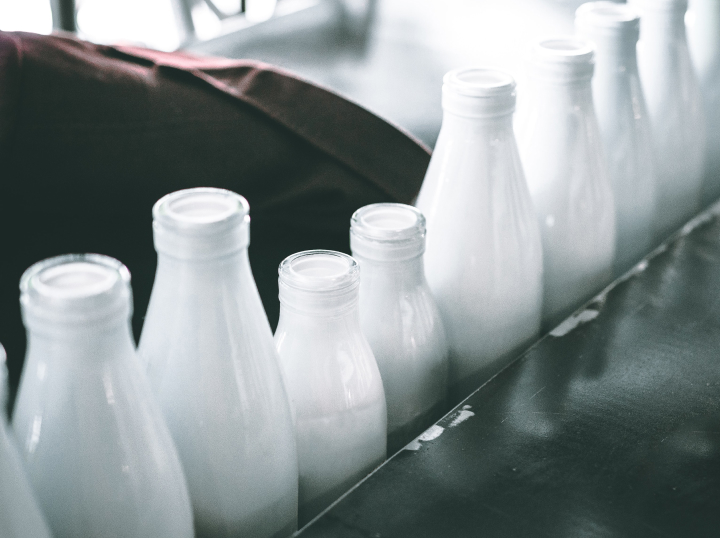Milk, Protein & Power
The Importance of High-Protein Foods for You and Your Family
Why Is it Important to Include High-Protein Foods in Your Family’s Diet?
No matter your age or nutrition goals, there are many reasons your body needs protein to be healthy and strong—from muscles to hair to healthy bones and teeth.
The latest research suggests that it’s not just about how much protein you need, but it’s also about when you get your protein. Protein foods for your kids, and for you, are important at every meal, especially breakfast.
Getting enough protein at breakfast can help you feel fuller longer, plus studies show eating breakfast helps kids concentrate and focus at school.
Read on to find out more about this important nutrient and learn why high-protein breakfasts for your kids, as well as for you, are great choices to start the day off right.
What Is Protein?
Along with carbohydrates and fats, protein is one of the three macronutrients, or nutrients that provide energy (or calories) in your diet. Protein long has been recognized as the foundation for the body. In fact, the word protein comes from the Greek word protos, which means first. Scientists now have discovered more than 30,000 proteins in our bodies. Each of these unique proteins is made up of a set of building blocks called amino acids, which food sources of protein provide. Nine amino acids are considered essential because your body can’t make the unique proteins it needs to survive without them. High-quality proteins—like those from milk, meat or fish—contain all nine of these essential amino acids.
Why Do We Need Protein?
Protein is the nutrient of the decade and its profile continues to rise. It’s a nutrient that more people want to get more of every day and often make sure to meet their daily protein requirements. That’s because protein is a valuable multitasker and does many important things in our bodies. In fact, protein is part of every cell in your body.
Getting enough protein, especially as part of a healthy breakfast, can help with:
Building lean muscle – Protein supplies your body with the amino acids it needs to build strong muscles. Along with being physically active, getting enough protein in your diet helps build and repair muscle.
Keep you and your kids fuller, for longer – Protein has a more powerful effect on satiety than either carbohydrates or fats. Including enough protein at breakfast can help everyone feel full and satisfied with their meal so you don’t feel hungry again by mid-morning.
Energy and focus – Power up your mornings with a high-protein breakfast. Many experts now recommend adults start the day with 25 to 30 grams of protein to help energize their morning. While the recommendations may differ for kids, (especially young kids who won’t likely require 25 to 30 grams at breakfast), it’s important for kids to get high-quality protein at every meal too. Including enough protein foods for kids at breakfast can help them stay focused until their next meal. Studies show that eating breakfast helps kids concentrate and focus at school.
Maintaining bone health – Along with key bone-building nutrients like calcium and vitamin D, research shows protein is also a key factor in building healthy bones.
Maintaining a healthy weight – Protein plays a role in maintaining a healthy weight. As part of a calorie-controlled diet, protein has been linked to more lean muscle and less fat. It’s important to keep in mind the type, amount and timing of your protein.
Foods High in Protein
Looking for Foods High in Protein for You and Your Kids?
While all foods with protein can help contribute to meeting your daily protein needs, it’s important to look at the amount of protein in each serving. Not all foods with protein on their own are good sources of protein. Check out these popular protein foods for your kids, as well as your morning meals, and how much protein they contribute (or don’t contribute) to a well-balanced diet. It’s also important to look at the quality of the protein you get. High-quality proteins—like those from milk, meat or fish—contain all nine of these essential amino acids.
| Food | Protein | High Quality |
|---|---|---|
| Sausage (1 serving) | 9g | x |
| Milk (1 cup) | 8g | x |
| Instant Oatmeal (1 packet) | 7g | |
| Peanut Butter (2 tbsp) | 7g | |
| Soy Beverage (1 cup) | 7g | x |
| Almonds (1 ounce) | 6g | |
| Egg (1 medium) | 6g | x |
| Bacon (3 slices) | 4g | x |
| Whole Wheat Toast (1 slice) | 4g | |
| OJ (1 cup) | 2g | |
| Avocado (1/5 medium) | 1g |
- USDA National Nutrient Database for Standard Reference, Release 27.
Why the Protein in Milk Is the Complete Package
When it comes to meeting your family’s daily protein requirements, not all foods are created equal.
In addition to considering the amount of protein in your food, there are several other factors to consider when it comes to choosing the right protein foods for you and your family.
With thirteen essential nutrients in each glass, milk is a delicious, simple and wholesome way to give your kids a natural source of high-quality protein plus other nutrients they need.
The Facts About Milk’s High-Quality Protein
When it comes to protein content, milk hits it out of the park. But milk is more than a good source of protein for your kids and for you. It also offers twelve other essential nutrients, including calcium and vitamin D—nutrients that most Americans, including children, are missing in their diet.
How much protein is in milk? You’ll find two types of protein in milk: whey (20 percent) and casein (80 percent). Both are considered high-quality proteins because they contain all essential amino acids in sufficient amounts to qualify milk as a good source of protein.
Milk is also a complete protein, which means that every glass contains a full mix of the essential amino acids our bodies need. Most plant-based protein sources are not considered complete proteins and other foods like protein bars often try to compensate for their lack of natural protein by adding in soy protein isolate or other processed forms of protein alongside added ingredients like sugar.
Plus, a recent study suggests a diet rich in milk protein is associated with better bone strength (higher bone mineral density) compared to some other patterns high in popular protein sources, like red meat.1
Milk is a simple, wholesome and affordable choice kids love that can be enjoyed in a glass, cup or bowl. You also can find it any many forms,from fat-free to whole to organic. Where else can you get 8 grams of protein, along with 8 other essential nutrients, for only 80 calories—all for around a quarter a glass? Nowhere, except in fat-free milk.
Milk is also a great post-workout beverage. In fact, low-fat chocolate milk has the right protein-to-carb ratio scientifically shown to help you recover after a tough workout.
How Milk Compares to Other Sources of Protein
When considering your daily protein intake and the best way to get protein, there’s good reason to add milk at meals. There are 8 grams of protein in a glass of milk—that’s a gram of high-quality protein in every ounce. Each serving of milk has more protein than the 6 grams found in a large egg. When compared to almond milk, which only has 1 gram, a glass of dairy milk has eight times as much protein. You may be surprised to learn there’s even new research underway that suggests milk could be the gold standard for protein, according to the World Health Organization.
In fact, when it comes to non-dairy, plant-based milks like almond or soy milk, people may not know that they don’t have the same naturally occurring nutrients as real, dairy milk. Most of the vitamins and minerals you see in almond milk’s nutrition facts panel like calcium and vitamin E are provided through fortification. While soy beverages provide natural protein and other nutrients, they are also typically fortified—in some cases it may have as many as five fortified nutrients—so its nutrient package more closely matches dairy milk.
It’s hard for kids to get enough nutrients, like calcium, that they need to grow up strong without milk in their diets.1 Moms trust milk for calcium, vitamin D and more. Milk is a great way for kids to get their bone-building nutrients—even more so than supplements or alternatives like vegetables or milk alternatives, according to the American Academy of Pediatrics.3
Take a look at how the protein in milk compares to other foods.
| Fat Free Milk | Vanilla Almond Milk* | Soy Milk* | Peanut Butter | Egg | |
|---|---|---|---|---|---|
| Protein | 8g | 1g | 5-8g | 7g | 6g |
| Calories | 80 | 90 | 110-150 | 190 | 70 |
| Quality | Complete | Incomplete | Complete | Incomplete | Complete |
| Cost† | 32g/dollar | 2g/dollar | 12-19 g/dollar | 28g/dollar | 35g/dollar |
| Nutrients†† | 9 nutrients | 7 nutrients | 9-14 nutrients | 5 nutrients | 6 nutrients |
- USDA National Nutrient Database for Standard Reference, Release 27.
- *Nutrients will differ by brand, flavor and fat content as nutrient fortification varies.
- †IRI Sales Data (milk, soymilk, almond milk), USDA Retail Prices (eggs), Average Online Grocery Prices (peanut butter). USDA Retail Prices based on available online data, may not be nationally representative.
- ††Nutrients signify food provides 10% or greater of the Daily Value of labeled nutrients.
Milk: A Great Protein Drink For Kids
It’s important for kids to get protein at every meal, especially breakfast. Protein at breakfast can help kids start their day off right. With its thirteen essential nutrients in each glass, milk is a delicious, simple and wholesome way to give your kids a natural source of high-quality protein, plus other nutrients they need.
The Dietary Guidelines recommend your kids get between two and three servings of dairy products, like milk, every day:
| Age | Servings |
|---|---|
| 2-3 years old | 2 |
| 4-8 years old | 2 1/2 |
| 9-18 years old | 3 |
Growing adolescents may need as many as four servings of dairy products, like milk, for bone growth too, according to the American Academy of Pediatrics (see page e1238).
Simply pair a glass of milk with their favorite breakfast foods—like eggs—or mix it into a smoothie or an overnight oats combination for an easy protein breakfast for kids.




